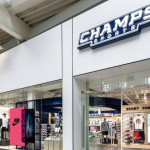Adid as Group reported earnings climbed 25 percent in its first quarter as sales grew 18 percent on a currency-neutral basis. Adidas brand and Reebok sales increased 18 percent and 24 percent respectively. Adidas now expects Adidas Group sales to increase at a high-single-digit rate on a currency-neutral basis in 2011 – up from a mid- to high-single-digit rate forecast previously – due to strength in emerging markets, Retail expansion as well as continued momentum at all key brands.
as Group reported earnings climbed 25 percent in its first quarter as sales grew 18 percent on a currency-neutral basis. Adidas brand and Reebok sales increased 18 percent and 24 percent respectively. Adidas now expects Adidas Group sales to increase at a high-single-digit rate on a currency-neutral basis in 2011 – up from a mid- to high-single-digit rate forecast previously – due to strength in emerging markets, Retail expansion as well as continued momentum at all key brands.
In the first quarter of 2011, the 18 percent gain on a currency-neutral basis was a result of double-digit sales increases in Wholesale, Retail and Other Businesses. Currency translation effects had a positive impact on sales in euro terms. Group revenues grew 22 percent to EUR3.273 billion ($4.65 bn) in the first quarter of 2011 from EUR2.674 billion in 2010.
“We are off to a powerful start in 2011 with record first quarter results,” commented Herbert Hainer, Adidas Group CEO. “Strong double-digit growth in key markets such as North America, Greater China and Russia and the successful introduction of new products and campaigns by Adidas, Reebok and TaylorMade underline the strength and desirability of our Group brands all around the globe.”
Wholesale and Retail segments drive strong growth
In the first quarter of 2011, currency-neutral Wholesale revenues increased 18 percent due to double-digit sales growth at both Adidas and Reebok. Currency-neutral Retail sales increased 22 percent versus the prior year, mainly as a result of double-digit growth of comparable store sales. Revenues in Other Businesses were up 14 percent on a currency-neutral basis, driven by double-digit sales increases at TaylorMade-Adidas Golf.
Currency translation effects had a positive impact on segmental sales in euro terms. Wholesale revenues increased 22 percent to EUR2.32 billion ($3.3 bn) in the first quarter of 2011 from EUR1.90 billion ($2.7 bn) in 2010. Retail sales rose 26 percent to EUR577 million ($819.3 mm) versus EUR459 million in the prior year. Sales in Other Businesses grew 19 percent to EUR376 million ($533.9 mm) in the first quarter of 2011 (2010: EUR316 million).
In the first quarter of 2011, currency-neutral Adidas Group sales grew in all regions. Revenues in Western Europe increased 14 percent on a currency-neutral basis, primarily as a result of double-digit sales growth in Germany, France and Italy. In European Emerging Markets, Group sales increased 26 percent on a currency-neutral basis due to growth in most of the region’s markets, in particular Russia. Sales for the Adidas Group in North America grew 26 percent on a currency-neutral basis driven by a 30 percent sales increase for Adidas and 22 percent sales growth for Reebok. Sales in Greater China increased 36 percent on a currency-neutral basis. Currency-neutral revenues in Other Asian Markets grew 7 percent due to increases in most markets, in particular South Korea. In Latin America, sales grew 15 percent on a currency-neutral basis, with double-digit increases in most of the region’s major markets. Currency translation effects had a positive impact on regional sales in euro terms.
Group gross margin nearly flat at 48.5 percent
The gross margin of the Adidas Group decreased 0.1 percentage points to 48.5 percent in the first quarter of 2011. Higher input costs were offset by the positive impact from less clearance sales as well as a larger share of higher-margin Retail sales. Gross profit for the Adidas Group grew 22 percent in the first quarter of 2011 to EUR1.587 billion ($2.25 bn) versus EUR1.300 billion in the prior year.
Operating profit increases 21 percent
Group operating profit increased 21 percent to EUR313 million ($444.5 mm) versus EUR260 million in 2010. As a percentage of sales, the operating margin of the Adidas Group was down 0.1 percentage points to 9.6 percent in the first quarter of 2011 (2010: 9.7 percent). This development was primarily due to the non-recurrence of prior year positive effects related to the settlement of a lawsuit and the divestiture of a trademark, which more than offset lower other operating expenses as a percentage of sales. Excluding these effects, on a comparable basis, the Group’s operating margin was up around 1.0 percentage points.
Financial income down 61 percent
Financial income decreased 61 percent to EUR5 million ($7.1 mm) in the first quarter of 2011 from EUR12 million in the prior year, mainly due to the non-recurrence of positive exchange rate effects in the prior year.
Financial expenses increased 14 percent to EUR33 million ($46.9 mm) in the first quarter of 2011 (2010: EUR29 million), mainly as a result of negative exchange rate effects. Excluding these effects, financial expenses decreased 16 percent.
Income before taxes (IBT) for the Adidas Group increased 17 percent to EUR285 million ($404.7 mm) from EUR243 million in 2010. IBT as a percentage of sales declined 0.4 percentage points to 8.7 percent in the first quarter of 2011 from 9.1 percent in 2010. This was primarily a result of the Group’s operating margin decrease and the lower financial result.
The Group’s net income attributable to shareholders increased to EUR209 million ($296.8 mm) in the first quarter of 2011 from EUR168 million in 2010. This represents an increase of 25 percent versus the prior year level. Higher IBT was the primary reason for this development. The Group’s tax rate decreased 4.0 percentage points to 26.5 percent in the first quarter of 2011 (2010: 30.5 percent), mainly due to a more favorable earnings mix.
In the first quarter of 2011, basic and diluted earnings per share amounted to EUR1.00 (2010: EUR0.80), representing an increase of 25 percent. The weighted average number of shares used in the calculation for both the current and prior year quarter is 209,216,186.
Group inventories up 21 percent
Group inventories increased 21 percent to EUR2.033 billion ($2.89 bn) at the end of March 2011 versus EUR1.680 billion in 2010. On a currency-neutral basis, inventories grew 23 percent, which reflects the Group’s expectations for continued growth in the coming quarters.
At the end of March 2011, Group receivables increased 8 percent to EUR2.155 billion ($3.06 bn) (2010: EUR1.987 billion) as a result of the Group sales growth. On a currency-neutral basis, receivables were up 10 percent. This growth is lower than the 18 percent currency-neutral Group sales increase in the first quarter of 2011 and mirrors strict discipline in the Group’s trade terms management and concerted collection efforts in all segments.
Net borrowings at March 31, 2011 amounted to EUR914 million ($1.3 bn), which represents a decrease of EUR444 million, or 33 percent, versus EUR1.359 billion at the end of March 2010. The decrease was driven by the strong operating cash flow development over the past 12 months. Currency translation had a positive effect in an amount of EUR28 million. The Group’s ratio of net borrowings over 12-month rolling EBITDA decreased to 0.8 at the end of March 2011 versus 1.4 in the prior year.
Updated guidance
The exceptional start to 2011 has set the Adidas Group up for another strong year of financial performance. Management now forecasts Adidas Group sales to increase at a high-single-digit rate on a currency-neutral basis in 2011 (previously: mid- to high-single-digit rate). High exposure to fast-growing emerging markets, the further expansion of Retail as well as continued momentum at all key brands will more than offset the non-recurrence of sales related to the 2010 FIFA World Cup.
Currency-neutral Wholesale segment revenues are now projected to increase at a mid- to high-single-digit rate compared to the prior year due to a higher strong performance of the Adidas brand in Greater China and North America (previously: mid-single-digit rate). Adidas Group currency-neutral Retail segment sales are projected to grow at a low-double-digit rate in 2011. Comparable store sales are expected to contribute to the revenue growth at a higher rate than the expansion of the Group’s own-retail store base. Revenues of Other Businesses are projected to increase at a mid-single-digit rate on a currency-neutral basis.
In 2011, the Adidas Group gross margin is forecasted to reach a level between 47.5 percent and 48.0 percent (2010: 47.8 percent). Group gross margin will benefit from positive regional mix effects. In addition, improvements in the Retail segment as well as at the Reebok brand will positively influence Adidas Group gross margin development. However, these positive effects will be offset by several factors. In particular, sourcing costs will increase significantly compared to the prior year as a result of rising raw material costs and capacity constraints. In addition, as a consequence of the tragic events in Japan during the first quarter of 2011, Group gross margin will be negatively impacted by sales declines in this market.
The Adidas Group’s other operating expenses as a percentage of sales are expected to decrease modestly in 2011 (2010: 42.1 percent). Sales and marketing working budget expenses as a percentage of sales are also projected to decline modestly compared to the prior year.
In 2011, the operating margin for the Adidas Group is expected to increase to a level between 7.5 percent and 8.0 percent (2010: 7.5 percent). In addition, Management expects lower interest expenses in 2011 due to a lower average level of net borrowings. As a result of these developments, earnings per share are expected to increase at a rate of 10 percent to 15 percent to a level between EUR2.98 and EUR3.12 (2010: EUR2.71).
Herbert Hainer stated: “The strong start to the year affirms our confidence in reaching all our projections for 2011. Although the unfortunate events in Japan will certainly affect our business in this important market, our global strength will provide ample opportunities to cover the expected shortfalls. As a result, our bottom-line guidance remains unchanged, meaning that 2011 will provide a fitting start to our strategic business plan Route 2015.”













